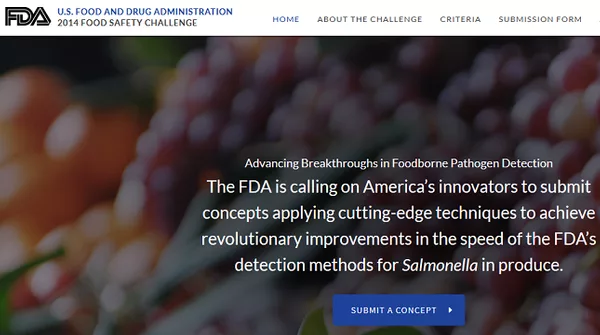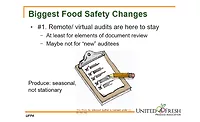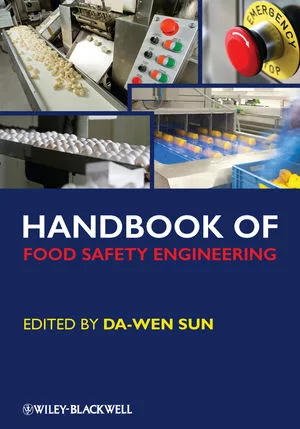FDA Kicks Off Food Safety Challenge to Speed Detection of Salmonella in Produce

The U.S. Food and Drug Administration (FDA) on Sept. 23 launched its 2014 Food Safety Challenge — a call to innovators from all disciplines to submit concepts that apply cutting-edge techniques to significantly improve the speed of detection methods for Salmonella in minimally processed fresh produce.
David G. White, PhD, the chief science officer and research director in FDA’s Office of Foods and Veterinary Medicine, posted this explanation on the FDA Voice blog:
The first challenge will focus on Salmonella, one of our most pervasive food safety problems today. According to the Centers for Disease Control and Prevention (CDC), Salmonella causes about 1.2 million illnesses in the United States every year, with about 23,000 hospitalizations and 450 deaths. Salmonella infections have been associated with eating foods, such as meat, eggs and fresh produce, contaminated with animal or human feces. The main causes of Salmonella illness are poultry and eggs. FDA’s goal is to prevent Salmonella contamination from happening, but we need to detect it quickly and efficiently when it is present in order to remove foods from the marketplace.
Through this innovation challenge, FDA wants to engage with others outside the agency who are not traditionally working in food safety — be they scientists, academicians, entrepreneurs, innovators, engineers or physicists — to find an ingenious approach to this problem so we can detect the disease-causing bacteria before they reach the consumer.
We’re focusing on produce first because it has a major impact on public health. According to the CDC, contaminated produce causes 46% of foodborne illness and 23% of foodborne illness-related deaths. But detecting low levels of Salmonella in produce can be like finding a needle in a haystack: difficult, expensive and time-consuming. Even a simple tomato might have up to a billion surface bacteria that do not cause harm to humans. Quickly detecting just the few types of bacteria that do cause harm, like Salmonella, is a daunting task.
Accurate detection is our highest priority. But rapid detection is also important. Testing for microbial contamination of produce currently can take up to several days. Meanwhile, the produce may sit in a warehouse, where its shelf life decreases with each passing day. Consumers can’t eat it, and producers can’t sell it. Those limitations affect the economy – from consumers to producers to farmers.
Maybe other scientists and innovators outside FDA have revolutionary techniques that they never thought of applying to food safety. We hope so. There are many new technologies that might be invaluable to our field laboratories, where we’re testing at least hundreds of pounds of produce a week.
We have already conducted a significant amount of research on food safety here at FDA. We have a lot of answers, but not all of them. Our hope is that this challenge will provide solutions that would increase the speed of FDA’s detection efforts without sacrificing specificity and sensitivity or comparability to reference methods. The challenge is open to U.S. citizens and permanent residents 18 and older and to entities incorporated in and maintaining a primary place of business in the United States, with certain exclusions for federal entities, employees and grantees. Participants will submit cutting-edge techniques to speed detection of Salmonella in produce. Their work will be evaluated by experts in food safety and foodborne pathogen detection from FDA, CDC and the U.S. Department of Agriculture. The winners (and there could be more than one) will share a total prize pool of $500,000.
Looking for quick answers on food safety topics?
Try Ask FSM, our new smart AI search tool.
Ask FSM →
These ideas will not only benefit U.S. consumers, but their effects will ultimately be felt worldwide. Everybody wants safe food, not just in the United States, but all over the world.
We hope that the 2014 FDA Food Safety Challenge creates an avenue for ideas and dialogue. We want to learn from others and adapt best practices so consumers can continue to trust the foods they eat.
To learn more about and sign up for the Food Safety Challenge, visit www.foodsafetychallenge.com.
Food Safety Challenge Timeline
The deadline to submit concepts is Sunday, Nov. 9, 2014 at 11:59PM EST. Finalists will be announced Jan. 7, 2015. A panel of food safety experts will choose up to five finalists to receive $20,000 and advance to the Field Accelerator phase (Jan. 8 - March 5). March 5 is Demo Day, when all finalists will present their refined concepts to the judges. The winner(s) will be announced and prize(s) will be awarded on March 12, 2015. A detailed schedule of all Challenge-related activities is available here.








